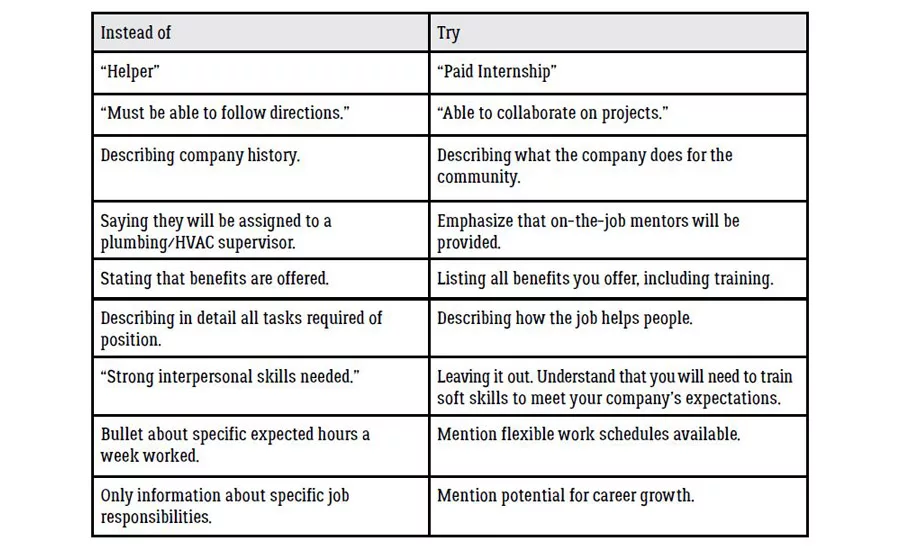Merry Beth Hall: Finding our future workforce

Gen Z individuals are concerned about the generational gap caused by technology in their professional and personal lives.

As we seek to acquire new talent with all of this in mind, take a look at some common phrases or items found in plumbing and HVAC industry in job ads.
“Insanity: Doing the same thing over and over and expecting the different results.” – Unknown
With the generational shift from X to Y (millennials), and now to Generation Z (people born from the mid-1990s to the early 2000s), the construction industry continues to be faced with challenges in how to recruit, train and retain qualified young workers to replace retiring employees.
To make an impact with potential employees, effective communications and marketing strategies are needed that, in most cases, may be totally different than what your company has considered before. What appealed to the baby boomers simply does not appeal to the up-and-coming workforce — specifically Generation Z.
Generation Z and the skills gap
Generation Z currently makes up nearly one-third of the U.S. population, according to the U.S. Census Bureau. This generation is made up of digital natives who are excellent multitaskers, have short attention spans, and are highly capable of self-directed or non-traditional learning.
A study of 4,000 Gen Z individuals found in “Gen Z @ Work” indicated that 92% are concerned about the generational gap caused by technology in their professional and personal lives. In the same study, 37% of these Gen Z individuals were concerned that technology negatively impacted their ability to develop and maintain strong interpersonal relationships and people skills.
According to an analysis by Deloitte, technology has “impacted the development of cognitive skills, including intellectual curiosity, among the next generation, creating the risk of skill gaps when they enter the workforce en masse. A shortfall in highly cognitive social skills such as problem solving, critical thinking, and communication could be particularly evident.”
Why is this skills gap such a problem for the construction industry? The problem is twofold.
First, this gap is a problem because so many businesses in our segment of the industry are customer service-oriented and require strong interpersonal communication skills.
But, even more critically, highly cognitive social skills are drivers for building tacit knowledge, which is the experiential knowledge such as installation or repair processes that are passed down through observation and context. This is the fundamental skill set for apprenticeship programs.
Changing how we acquire talent for Gen Z
As contractors look toward acquiring talent from this new generation, examining what we do as the older generations is critical. How many of us wear back-breaking apprenticeships or first jobs as a badge of honor?
PM columnist Kenny Chapman said in his February 2018 column, “Learning How to Attract and Retain Younger Employees,” that while your past has served you well, the younger generation is not interested in your past. However, they are interested in how to make the world a better place, and that includes making your business and the lives of your customers better.
Gen Z wants to know that they are valued and that the business owner cares about their success. They want to work for businesses that give back to the community. And they want to know up front every job perk they can expect with the position along with what growth opportunities they will have.
Specifically, this generation values technology, collaboration, road maps for growth and development, flexibility, training, career advancement, doing meaningful work, stability, and a consistent paycheck.
As part of an ongoing workforce development effort, PHCC — National Association and the PHCC Educational Foundation have tapped into youth-oriented research studies to guide the development of content that appeals to the younger generations. What we’ve found is that certain terminology and images work much better than others.
As we seek to acquire new talent with all of this in mind, take a look at some common phrases or items found in plumbing and HVAC industry in job ads. Some in our industry use terminology that is outdated and not meaningful to the younger generation. I’m not talking about being politically correct — I’m talking about choosing phrasing that is meaningful in the 21st century. By simply substituting more Gen Z-friendly language, we may find we can attract the best and brightest of this younger generation.
We also know Gen Z is technologically savvy and that they frequently watch online videos. In “Action-Packed Tips for Recruiting Generation Z Employees,” Jeanette Maister suggests adding an online video that gives an intro to your company or the trade or gives tips on your interview process. Be sure to add humor to show you offer a fun work environment, and you will watch the number of applicants increase.
A more diverse applicant pool
Most efforts over the past 20 years have been heavily focused on reaching out to middle and high school students to tell them about what our industry has to offer. While this type of outreach is important, we are missing a couple of potential applicant pools that could produce high-quality candidates for apprenticeships.
The first applicant pool that will provide our industry with excellent candidates is recently discharged military veterans. If there is a military base anywhere nearby, a local apprenticeship school advisory committee or contractor group should contact the transition office at your local military base about opportunities to reach out to new veterans who will be leaving military service.
The second applicant pool that has potential to offer ideal candidates is recent graduates from community college associate degree programs. One of the challenges many students in these two-year degree programs find is they are underemployed after completing their degrees, yet they do not want to pursue a four-year degree. Many of these individuals will have the communication and math skills needed for success in our industry. Try reaching out to your local community college workforce development center to see if they will share information about recent graduates or if your company can participate in a job fair at the college.
Regardless of the approach we choose, the time has come for contractors to embrace new ways of connecting with the younger workers that our industry so desperately needs. As a result, we will find we can gain some excellent young employees who we can train to be our future.
Looking for a reprint of this article?
From high-res PDFs to custom plaques, order your copy today!







